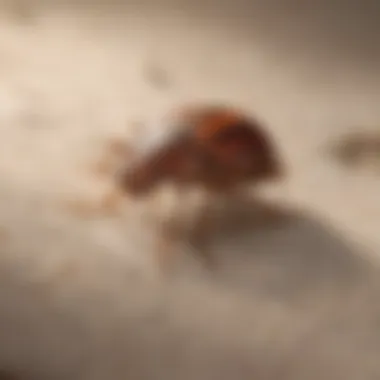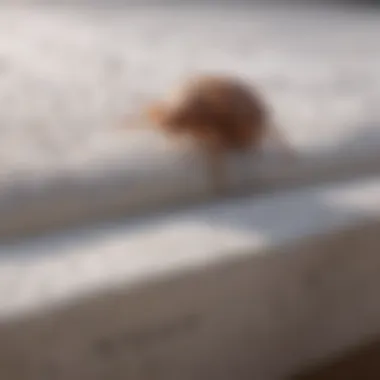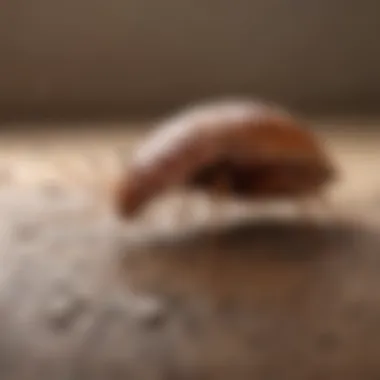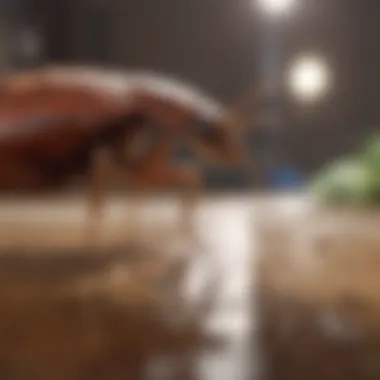Effective Bed Bug Elimination Without Exterminators


Intro
Bed bugs are small, elusive pests that have become a significant concern for many households. Understanding their biology, habits, and how to address an infestation without hiring professionals is crucial. This article serves as a comprehensive guide to eliminating bed bugs effectively and safely through DIY methods.
Animal Species Profile
Preamble to the animal species
Bed bugs, scientifically known as Cimex lectularius, are parasitic insects that primarily feed on human blood. They are often found in warm, sheltered areas, making beds the perfect host.
Physical characteristics and appearance
Adult bed bugs are about the size of an apple seed, measuring approximately 4-5 mm in length. They are reddish-brown in color and have a flat, oval shape. An important feature is their lack of wings, which means they cannot fly but can crawl rapidly.
Natural habitat and distribution
Bed bugs thrive in human dwellings, particularly in bedrooms. They often hide in mattress seams, bed frames, and even electrical outlets. Their ability to hitchhike on luggage, clothing, and furniture allows them to spread quickly, leading to infestations across various locations.
Behavior and social interactions
Bed bugs are nocturnal and prefer to feed at night when their hosts are asleep. They are known to be solitary insects, unless in a heavily infested area. They typically remain hidden during the day, emerging only to find a blood meal.
Recognizing Infestation Signs
Identifying an infestation early is vital for effective control. Common signs include:
- Bite marks: Red, itchy welts on exposed skin, often in clusters.
- Fecal spots: Dark stains on bedding or walls, which indicate bed bug excrement.
- Eggs and skins: Tiny, white eggs and shed skins can be found near their hiding spots.
DIY Strategies for Bed Bug Elimination
Inspection techniques
Before employing any treatments, a thorough inspection is necessary. Check bedding, furniture, and surrounding areas for any signs mentioned above. Use a flashlight for better visibility in darker spaces.
Cleaning and vacuuming
Start by removing all bedding and washing it in hot water. A hot dryer cycle will kill bed bugs and their eggs. Vacuuming is essential for physical removal. Focus on:
- Mattresses and box springs
- Baseboards and carpets
- Furniture joints and cracks
Heat treatment
Heat is an effective method of killing bed bugs. Use steam cleaners on mattresses and carpets, ensuring the steam reaches at least 120°F. Alternatively, you can place small items in a hot dryer for at least 30 minutes.
Using diatomaceous earth
Food-grade diatomaceous earth can be applied to infested areas. It is abrasive to bed bugs and can lead to their dehydration. Make sure to wear a mask while applying it, and leave it in place for several days before vacuuming up the residue.
Chemical options
If necessary, use insecticides labeled for bed bug control. Follow all safety instructions and ensure pets and people are out of the area during treatment.
Understanding Bed Bugs
Understanding bed bugs is critical when dealing with an infestation. Knowledge about their biology, behavior, and signs of presence equips individuals to tackle this issue effectively. This section delves into important aspects of bed bugs to provide a clear foundation for DIY extermination strategies.
Biology of Bed Bugs


Bed bugs, scientifically known as Cimex lectularius, are small, wingless insects. Adults are typically about the size of an apple seed, ranging from 4 to 5 millimeters in length. Their bodies are flat, oval-shaped, and reddish-brown. This unique shape allows them to hide in narrow spaces.
Bed bugs do not have wings, but they move quickly across floors, walls, and ceilings. They are nocturnal, primarily feeding at night, which contributes to their elusive nature. Their piercing mouthparts allow them to feed on the blood of their hosts, usually humans. They can survive several months without a meal, enabling them to endure periods of low food availability. Understanding their physical characteristics is essential to accurately identify them during an infestation.
Life Cycle and Behavior
The life cycle of bed bugs consists of several stages: egg, nymph, and adult. Female bed bugs can lay between one to five eggs per day, which are tiny, about 1 millimeter in size. Eggs hatch in about a week under optimal conditions, resulting in nymphs that will molt five times before reaching adulthood.
Each stage requires a blood meal to progress, making their feeding behavior a crucial part of their life cycle. Bed bugs are social insects; they often hide in groups, usually in cracks and crevices during the day. Recognizing their behavior can help in locating their hiding spots when dealing with an infestation.
Identifying Bed Bug Infestations
Identifying a bed bug infestation early is vital in controlling it. Signs include:
- Physical Evidence: Look for small, rust-colored stains on bedding or furniture, which are fecal matter.
- Eggs and Shells: Tiny, white eggs and molted skins can be found in hiding places.
- Bites: Bed bug bites are usually red and itchy, often occurring in clusters or straight lines.
Inspect commonly affected areas such as the seams of mattresses, bed frames, and furnishings near sleeping areas. A thorough inspection increases the chances of early detection, leading to a more effective elimination process.
The more you know about bed bugs, the better equipped you will be to handle an infestation.
Understanding these aspects of bed bugs lays the groundwork for effective removal strategies that do not require professional help.
Signs of Bed Bug Presence
Identifying signs of bed bug presence is a critical step in effective pest management. An early detection can significantly decrease the risk of a full-fledged infestation, allowing for prompt intervention. This section delves into various indicators that suggest the presence of these pests, helping readers to act swiftly and decisively. By understanding the signs, you can reduce potential discomfort and health hazards associated with bed bugs.
Visual Cues
Visual cues are often the most discernible indicators of a bed bug infestation. Look for small, reddish-brown insects, about the size of an apple seed. Bed bugs typically hide in tight spaces during the day and emerge at night.
Besides live insects, check for other signs:
- Exoskeletons: As they grow, bed bugs shed their exoskeletons. Finding these sheds can be a telltale sign of an ongoing infestation.
- Stains and Spots: Rusty or dark spots on sheets or mattress seams can indicate bed bug excrement.
- Eggs: Tiny, white eggs (approximately 1mm in size) may often be hidden in seams or cracks.
Frequent inspections in commonly infested areas are essential for recognizing these visual cues early.
Physical Symptoms
Physical symptoms can manifest in those who have been bitten by bed bugs. Not everyone reacts the same way to their bites, but common reactions include:
- Red, Itchy Bumps: These usually appear in clusters, primarily on exposed skin. The itching may lead to scratching, which could increase the risk of secondary infections.
- Allergic Reactions: In more sensitive individuals, bites may cause significant allergic reactions, bringing about hives or other dermatological issues.
- Sleep Disruptions: The discomfort of itching may lead to sleep disturbances, impacting overall health and quality of life.
Being aware of these symptoms is important for understanding the potential impact of bed bugs, both physically and mentally.
Common Habitats
Bed bugs are known to inhabit specific areas that provide warmth and proximity to humans. They often hide in:
- Mattresses and Box Springs: These are prime locations due to warmth and ease of access for feeding.
- Furniture Joints: Whether it's couches or chairs, the joints and seams are common hiding spots.
- Baseboards and Wall Cracks: Bed bugs can easily hide in narrow gaps, making walls and baseboards susceptible.
- Luggage and Clothing: They often travel with people, hiding in luggage when returning from trips.
To minimize infestations, keep a clean living space. Regularly inspect these common habitats to ensure you catch any signs early.
Taking proactive measures can save time and effort in battling bed bugs. Remember, early detection is key to effective elimination.
DIY Techniques for Bed Bug Removal
Dealing with bed bugs can be a daunting task, but understanding and implementing effective DIY techniques can significantly lessen the burden. DIY methods provide a cost-effective means to tackle infestations, offering homeowners and renters strategies to eliminate these pests without calling in professionals. Utilizing these approaches not only empowers individuals but also fosters a sense of control over the situation.


Heat Treatments
Heat treatments are one of the most effective methods for killing bed bugs at all life stages. Bed bugs are sensitive to high temperatures. Exposing them to temperatures above 120°F (49°C) for an extended period can effectively eradicate them. This method works particularly well because it penetrates deep into materials like mattresses and carpets, which are common hiding spots.
To apply heat treatment safely, you may use a clothes dryer on high heat for items such as bedding and clothing. Furniture can be treated using portable heaters, ensuring the temperature remains steady throughout the area. However, caution is needed to avoid damage to items or fire hazards.
Vacuuming Strategies
Vacuuming is a practical step in the removal process. It helps eliminate visible bed bugs and their eggs from surfaces. Using a vacuum cleaner with a HEPA filter is recommended because it can trap tiny particles, including allergens and insect debris.
When vacuuming, focus on areas like:
- Mattresses and box springs
- Bed frames and headboards
- Baseboards and carpets
- Cracks and crevices in furniture
After vacuuming, promptly dispose of the vacuum bag outside your home or clean the canister. This process reduces the chances of bed bugs escaping and re-infesting your living space.
Laundry and Fabrics Management
Effective laundry practices play an essential role in bed bug removal. Washing fabrics in hot water kills bed bugs and their eggs. Items to wash include:
- Bedding and linens
- Curtains and drapes
- Clothing that may have come into contact with infested areas
To ensure maximum efficacy, dry these items on high heat for at least 30 minutes. For items that cannot be washed, consider placing them in a sealed plastic bag for an extended period. This method, known as encasement, starves the bugs without exposing surrounding areas to risks.
Using Diatomaceous Earth
Diatomaceous earth (DE) is a natural powder derived from fossilized algae. It’s effective at dehydrating and killing bed bugs upon contact. When applying DE, it’s essential to focus on areas known to harbor bed bugs, such as:
- Mattress seams
- Baseboards
- Any visible cracks
To use DE safely, wear a mask and gloves. It is a slow-working solution, so patience is needed; it may take days for complete effectiveness. Regularly reapply the powder to maintain its efficacy.
Chemical Solutions: An Overview
Chemical solutions can supplement other DIY methods but should be approached with caution. Various over-the-counter insecticides are available that target bed bugs specifically. When selecting these products, look for those labeled for bed bug use, and read the instructions carefully.
Ensure to handle chemical solutions with care, as they can pose health risks if misused. Prioritize those that have been approved by relevant safety boards to mitigate any potential hazards.
Combining chemical methods with non-chemical strategies, like vacuuming and heat, typically proves more effective. Always ensure proper ventilation during application and follow safety precautions.
Preventative Measures
Preventative measures are essential for effectively managing and eliminating bed bugs without the assistance of an exterminator. Taking proactive steps can significantly reduce the risk of infestation in your home and help maintain a pest-free environment. Understanding the habits of bed bugs and implementing simple strategies can minimize their chances of establishing themselves in your living space.
Regular Inspection Protocols
Regular inspection protocols play a crucial role in early detection of bed bugs. Conducting routine checks in potential hotspots can help identify problems before they escalate. Focus on areas such as mattresses, box springs, and crevices in furniture where bed bugs often hide.
- Inspect these key areas thoroughly:
- Mattress seams
- Bed frames
- Baseboards and electrical outlets
It's also beneficial to check for signs like rust-colored stains or small black dots, which may indicate fecal matter. Make it a habit to inspect your space after traveling or hosting guests to catch any potential infestations early.
Best Practices for Travel
When traveling, bed bugs can hitch a ride in your luggage or clothing, introducing them to your home. Practicing good preventive measures while on the go is paramount to avoid bringing these pests back. Here are some best practices for travel:


- Inspect hotel rooms upon arrival. Examine the mattress, headboard, and nightstands for signs of bed bugs.
- Keep luggage elevated. Avoid placing bags on the bed or floor; use luggage racks instead.
- Use plastic bags for dirty laundry, keeping it separate from clean clothes.
By following these simple travel tips, you can significantly reduce the risk of introducing bed bugs into your home.
Mitigating Risks within Your Home
Mitigating risks within your home requires a commitment to maintenance and cleanliness. Simple habits can greatly decrease the likelihood of attracting bed bugs. Here are some suggestions:
- Declutter your living spaces. Reducing clutter makes inspections easier and gives bed bugs fewer hiding spots.
- Seal cracks and crevices in walls, floors, and furniture. This limits potential hiding spots.
- Wash bedding frequently in hot water and dry on high heat to kill any potential bed bugs or eggs that may be present.
Regularly implementing these measures can lead to a safer living environment. It fosters a proactive mindset that may prevent serious infestations down the line.
Through simple yet effective preventative measures, you can protect your home from bed bugs while ensuring a more comfortable living space. Maintaining vigilance is key to effectively managing these pests.
When to Seek Professional Help
The significance of knowing when to call in an expert cannot be overstated when dealing with bed bugs. While DIY methods are effective for minor encounters, certain situations warrant professional intervention. Recognizing these thresholds ensures that you don't suffer unnecessary frustration, time wasted, or an escalation of the problem.
Assessing the Severity of Infestation
Determining the extent of a bed bug infestation is critical. Several factors can help gauge whether it is time to seek professional help.
- Number of Bed Bugs: If you notice a rapid increase in the number of bed bugs, or if you find them in multiple rooms, this is a strong indication that you might need professional assistance.
- Location of Infestation: If bed bugs are spreading beyond your immediate sleeping area, like into your living or dining areas, this is another sign of a significant issue.
- Duration of Issue: If you've been battling the problem for weeks with minimal success, it is likely a good idea to consult an expert. Ongoing infestations often require a professional-level treatment plan designed for thorough eradication.
- Physical Reactions: If you or anyone in your household experiences allergic reactions or skin infections due to bites, it’s wise to seek help. This can lead to more serious health complications.
Assessing these elements can help create a clearer picture of the situation. It is essential to make informed decisions at this stage to avoid more significant consequences.
Understanding Treatment Options
If you decide to get professional help, it’s important to understand the various treatment options available. Exterminators utilize several methods, depending on the severity of the infestation and the specific conditions of your environment.
- Heat Treatment: A common and effective method, heat treatment raises the temperature of an affected area to over 120 degrees Fahrenheit, effectively killing bed bugs at all life stages.
- Chemical Treatments: There are various insecticides designed to target bed bugs. Professionals often use a combination of them for better results, but care must be taken to ensure safety, especially for pets and children.
- Integrated Pest Management (IPM): Many professionals advocate for IPM strategies. This approach combines various methods—monitoring, sanitation, and both chemical and non-chemical control methods—to create a comprehensive plan for eradication.
- Fumigation: In severe cases, fumigation is an option. This process involves enclosing the entire property and releasing a gas that penetrates all areas, killing bed bugs effectively.
Understanding these options can help you have informed discussions with pest control professionals, leading to a more tailored solution for your situation.
Reflection: Consulting professionals is not a mark of failure. It's a wise and often necessary decision when faced with persistent bed bug problems. The goal is to reclaim your space safely and effectively.
Long-Term Solutions and Considerations
Long-term solutions for bed bug elimination are vital for ensuring that once these pests are gone, they do not return. A comprehensive approach goes beyond immediate fixes and addresses the root causes of infestations. Understanding the environment in which bed bugs thrive plays a significant role in developing effective, lasting strategies. In this section, we will explore various elements involving long-term solutions and considerations.
Effectiveness of DIY Methods
The effectiveness of DIY methods for bed bug eradication can vary greatly depending on the technique used and the extent of the infestation. Many individuals have had success using techniques like heat treatment, vacuuming, and the application of diatomaceous earth. However, it is important to note that while these methods can provide relief, they may not always eliminate the problem completely.
To ensure the best results, following multiple approaches can be more effective than relying on a single method. For example:
- Heat Treatments: High temperatures can kill bed bugs in all life stages. However, care must be taken to ensure that heat penetrates throughout the space where infestation is suspected.
- Vacuuming Strategies: Regular vacuuming can significantly reduce the bed bug population. Ensure to dispose of the vacuum bag promptly after use.
- Diatomaceous Earth: This natural substance can be sprinkled in areas where bed bugs hide. It works by damaging their exoskeleton, leading to dehydration and death.
Combating Resistance
Bed bugs are notorious for rapidly developing resistance to common pesticides. This has become a significant challenge when dealing with infestations. Homeowners may use chemical solutions, yet if bed bugs are resistant, these efforts can be futile and even harmful. Thus, it is crucial to adapt to new methods.
One effective strategy is to:
- Rotate Chemical Treatments: Using different substances periodically can help mitigate resistance.
- Integrate Non-Chemical Methods: Combining chemical and non-chemical approaches results in a more well-rounded thrust against these pests.
- Stay Updated on New Products: The pest control industry regularly develops new treatments that can be effective against resistant populations. Keeping informed about these innovations can enhance your control efforts.
Developing an Integrated Pest Management Plan
Creating an Integrated Pest Management (IPM) plan is essential for long-term control and prevention of bed bugs. This approach enables homeowners to use a combination of methods tailored to their specific situations. Here are some key components of an IPM plan:
- Regular Monitoring: Establish a schedule to check for signs of bed bugs and to assess the effectiveness of your control methods.
- Education and Awareness: Understanding how bed bugs move, reproduce, and hide is crucial in informing your strategies.
- Community Involvement: Engaging with neighbors and local organizations can foster a unified approach, making entire communities less prone to infestation.
Remember, the battle against bed bugs is ongoing. Consistent efforts and adapting new techniques over time are often necessary to maintain a pest-free environment.
By considering all these factors, involving the right methods, and developing a solid plan, you will be better prepared to not only tackle bed bugs now but also ensure they do not return in the future.







